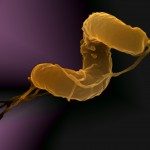Link to Pubmed [PMID] – 38173305
Link to DOI – 10.1111/mmi.15218
Mol Microbiol 2024 Feb; 121(2): 260-274
There is growing evidence that bacterial morphology is closely related to their lifestyle. The helical Helicobacter pylori relies on its unique shape for survival and efficient colonization of the human stomach. Yet, they have been observed to transform into another distinctive morphology, the spherical coccoid. Despite being hypothesized to be involved in the persistence and transmission of this species, years of effort in deciphering the roles of the coccoid form remain fruitless since contrasting observations regarding its lifestyle were reported. Here, we discuss the two forms of H. pylori with a focus on the coccoid form, the molecular mechanism behind its morphological transformation, and experimental approaches to further develop our understanding of this phenomenon. We also propose a putative mechanism of the coccoid formation in H. pylori through induction of a type-I toxin-antitoxin (TA) system recently shown to influence the morphology of this species.


